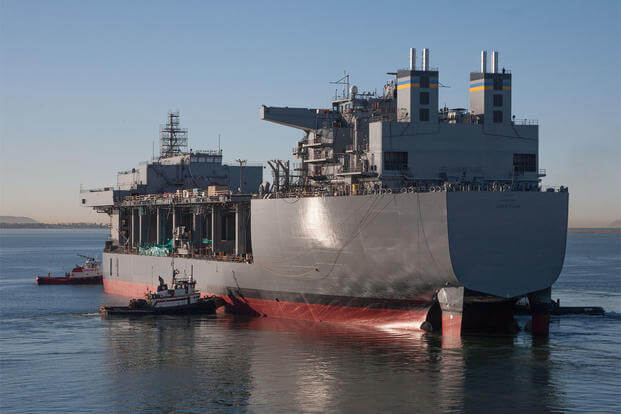SAN DIEGO -- The Navy's first Afloat Forward Staging Base (AFSB) variant of the Mobile Landing Platform, USNS Lewis B. Puller, was delivered to the Navy in San Diego, June 12.
Built by General Dynamics NASSCO, delivery of the ship follows a series of at-sea tests and trials in San Diego.
The Mobile Landing Platform (MLP) AFSB variant is optimized to support a variety of maritime-based missions with an added flight deck, berthing, fuel storage, equipment storage, and repair spaces.
"This ship represents a leap forward in flexible capability for the U.S. Navy," said Capt. Henry Stevens, Strategic and Theater Sealift program manager for Program Executive Office (PEO), Ships. "NASSCO was able to leverage a mature design and hot production line to meet the Navy's requirements for an AFSB platform while minimizing program cost and risk."
The MLP program comprises five ships across two variants in support of the Maritime Prepositioning Force (MPF) and an AFSB initiative. USNS Montford Point (MLP 1) and USNS John Glenn (MLP 2) were delivered and are currently serving in the fleet. MLP 4, also an AFSB variant, is under construction and a fifth AFSB ship is planned for procurement in fiscal year 2017.
MLPs are highly flexible platforms that provide logistics movement from sea to shore supporting a broad range of military operations. The AFSB variant is designed around four core capabilities: aviation, berthing, equipment staging area, and command and control.
The MLP AFSB will primarily support Aviation Mine Countermeasure and Special Operations missions. Additional features include a large flight deck and hangar with two aviation operating spots capable of handling MH-53E equivalent helicopters; berthing and messing accommodations; work spaces and ordnance storage for embarked forces; enhanced command, control, communications, computers, and intelligence (C4I) to support embarked force mission planning; and execution and reconfigurable mission deck area to store embarked force equipment to include mine sleds and rigid-hull inflatable boats (RHIBs).
As one of the Defense Department's largest acquisition organizations, PEO Ships is responsible for executing the development and procurement of all destroyers, amphibious ships, special mission and support ships, and special warfare craft. Delivering high-quality warfighting assets -- while balancing affordability and capability -- is key to supporting the Navy's Maritime Strategy.




























